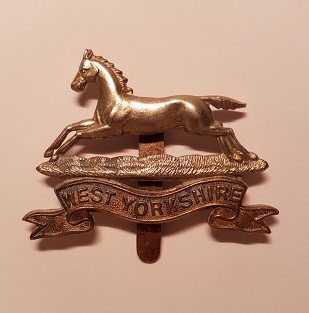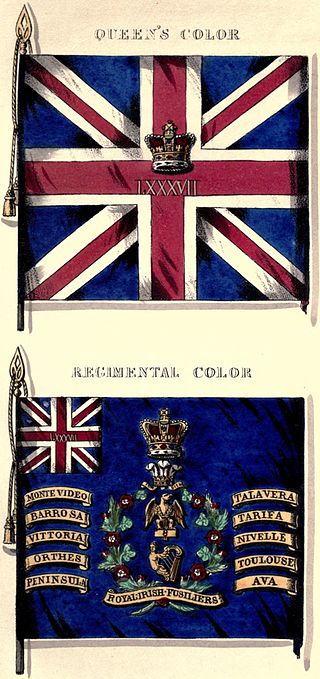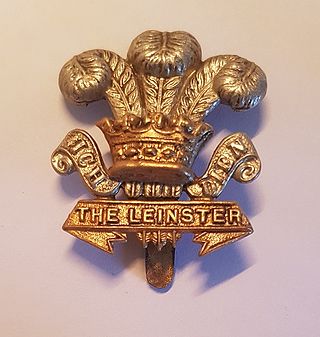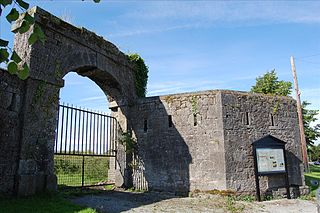The 102nd Regiment of Foot was a regiment of the British Army raised by the Honourable East India Company in 1742. It transferred to the command of the British Army in 1862. Under the Childers Reforms it amalgamated with the 103rd Regiment of Foot in 1881 to form the Royal Dublin Fusiliers.

The West Yorkshire Regiment (Prince of Wales's Own) (14th Foot) was an infantry regiment of the British Army. In 1958 it amalgamated with the East Yorkshire Regiment (15th Foot) to form the Prince of Wales's Own Regiment of Yorkshire which was, on 6 June 2006, amalgamated with the Green Howards and the Duke of Wellington's Regiment (West Riding) to form the Yorkshire Regiment (14th/15th, 19th and 33rd/76th Foot).

The South Wales Borderers was a line infantry regiment of the British Army in existence for 280 years.
The 105th Regiment of Foot (Madras Light Infantry) was an infantry regiment of the British Army, raised by the Honourable East India Company in 1766. Under the Childers Reforms it amalgamated with the 51st (2nd Yorkshire West Riding) Regiment of Foot to form the King's Own Yorkshire Light Infantry.
The 37th Regiment of Foot was a line infantry regiment of the British Army, raised in Ireland in February 1702. Under the Childers Reforms it amalgamated with the 67th Regiment of Foot to become the Hampshire Regiment in 1881.
The 97th Regiment of Foot was an infantry regiment of the British Army, formed in 1824 and amalgamated into the Queen's Own in 1881.

The 87th Regiment of Foot was an infantry regiment of the British Army, raised in 1793. Under the Childers Reforms it amalgamated with the 89th Regiment of Foot to form the Princess Victoria's in 1881.

The 86th Regiment of Foot was an infantry regiment of the British Army, raised in 1793. Under the Childers Reforms it amalgamated with the 83rd Regiment of Foot to form the Royal Irish Rifles in 1881.
The 108th Regiment of Foot (Madras Infantry) was an infantry regiment of the British Army. However, it was raised initially as part of the Madras Army, by the East India Company (EIC) in 1766.

The 106th Regiment of Foot (Bombay Light Infantry) was an infantry regiment of the British Army from 1862 to 1881, the third to bear the number after the Black Musqueteers (1761–1763) and a regiment raised briefly in 1794. It was formed by renaming the 2nd Bombay European Regiment, formed by the Honourable East India Company in 1839. In 1881 the 106th Regiment was joined with the 68th (Durham) Regiment of Foot (Light Infantry) to form the Durham Light Infantry, as its second regular battalion.

The Prince of Wales's Leinster Regiment (Royal Canadians) was an infantry regiment of the line in the British Army, formed in 1881 by the amalgamation of the 100th (Prince of Wales's Royal Canadian) Regiment of Foot and the 109th Regiment of Foot (Bombay Infantry). The 100th Foot was first raised in 1858 and the 109th was first raised in 1853. Between the time of its formation and Irish independence, it was one of eight Irish regiments raised largely in Ireland, with its Birr Barracks home depot in Birr. It was disbanded with the Partition of Ireland following establishment of the independent Irish Free State in 1922 when the five regiments that had their traditional recruiting grounds in the counties of the new state were disbanded.

The 103rd Regiment of Foot (Royal Bombay Fusiliers) was a regiment raised in 1662. It transferred to the command of the Honourable East India Company in 1668 and to the command of the British Army in 1862. Under the Childers Reforms it amalgamated with the 102nd Regiment of Foot (Royal Madras Fusiliers) to form the Royal Dublin Fusiliers in 1881.
The 101st Regiment of Foot (Royal Bengal Fusiliers) was an infantry regiment of the East India Company and British Army that existed from 1652 to 1881. The regiment was raised in India in 1652 by the East India Company as the company's first non-native infantry regiment. Over the following two centuries, the regiment was involved in nearly all of the East India Company's conflicts which consolidated British rule over India. The Royal Bengal Fusiliers was transferred to the command of the British Army in 1862 following the Indian Mutiny of 1857 and the end of Company rule in India. Under the Childers Reforms it amalgamated with the 104th Regiment of Foot (Bengal Fusiliers) to form the Royal Munster Fusiliers in 1881.

The 100th Regiment of Foot was a British Army regiment, raised in 1858. Under the Childers Reforms it amalgamated with the 109th Regiment of Foot to form the Prince of Wales's Leinster Regiment in 1881.
The 3rd Bombay European Regiment was an infantry regiment raised by the British East India Company in 1853. They were created originally for the defence of Bombay (Mumbai) and were stationed initially in Pune, but they were soon called upon to quell the Indian Rebellion of 1857.

The 90th Perthshire Light Infantry was a Scottish light infantry regiment of the British Army, raised in 1794. Under the Childers Reforms it amalgamated with the 26th (Cameronian) Regiment of Foot to form the Cameronians in 1881.
The 104th Regiment of Foot was a regiment of the British Army, raised by the Honourable East India Company in 1765. Under the Childers Reforms it amalgamated with the 101st Regiment of Foot to form the Royal Munster Fusiliers.
The 107th Regiment of Foot was an infantry regiment of the British Army, raised by the East India Company in 1765. Under the Childers Reforms, it amalgamated with the 35th Regiment of Foot to form the Royal Sussex Regiment.
The 98th Regiment of Foot was an infantry regiment of the British Army. It was originally raised in 1824 as the 98th Regiment of Foot, before assuming the title of the 98th Regiment of Foot in 1876. Later, in 1881, following the Childers Reforms of the British Army, the regiment was amalgamated with the 64th Regiment of Foot to become the Prince of Wales's Regiment. As the 64th Foot was senior to the 98th, the 98th became the 2nd Battalion in the new regiment. Throughout the course of the regiment's existence it served mostly overseas in South Africa, China and India.

Birr Barracks also known as Crinkill Barracks was a military installation in Crinkill, near Birr, County Offaly in Ireland.










